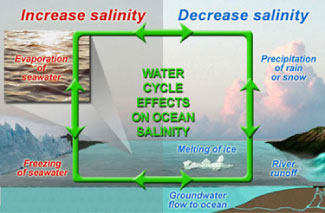 |
NASA | GSFC | JPL | Site Map |
|
|
 |
 |
Education: Student Outcomes |
Filtered by outcome, asset type: 5-8q2, tool Click here to begin a new search | |||||||||
Outcome: Explain how the processes of the water cycle (e.g., evaporation, precipitation) relate to the oceans. | |||||||||
Grade level: 5-8 Theme: water cycle Tool: http://aquarius.nasa.gov/education-datatools.html
Salinity patterns are governed by geographic differences in the "water budget." For example, like on continents, some areas of the ocean are rainy whereas others are arid and "desert-like." To learn more about the factors that influence salinity patterns, we invite you investigate five pairs of data maps centered over the North Atlantic Ocean (listed below). Each map shows monthly conditions based on long-term averages. The challenge is to find the data set that most closely corresponds to sea surface salinity patterns. Grade level 5-8: Look at monthly maps of: air temperature vs. sea surface salinity and precipitation vs. sea surface salinity. Are any of these data sets closely correlated with solar energy input (e.g., seasonal change)? Grade level 9-12: For the North Atlantic Ocean, look at monthly maps of air temperature vs. sea surface salinity and precipitation vs. sea surface salinity and evaporation vs. sea surface salinity. Are changes in these data sets closely correlated with solar energy input (e.g., seasonal change) in the North Atlantic ocean? Look at these videos -- Sea Surface Salinity and Components of the Water Cycle for global data sets of sea surface temperature, precipitation, and evaporation. | |||||||||
